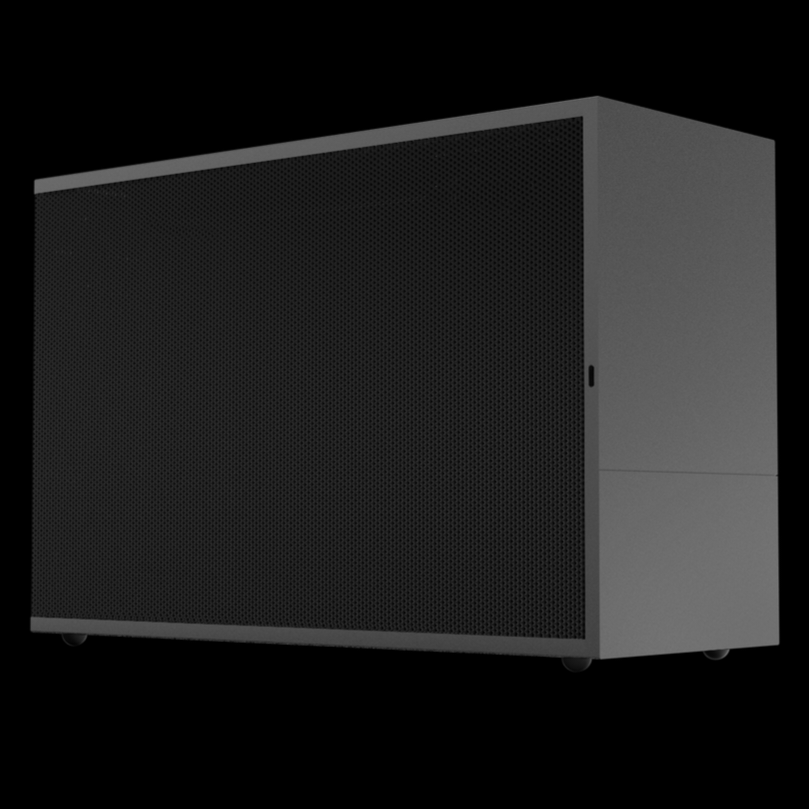The T1 v2.5 is a slightly modified version of the FormD T1 v2.1, under the NCASE portfolio. Case pricing starts at US$185 for black variant, $215 for gunmetal and pricing for white being subject to change as just placeholder. Check out the T1 collection on NCASE store.
SPECIFICATIONS


| MODEL | FormD T1 v2.1 (Sandwich Kit) | T1 v2.5 (Sandwich Kit) |
| OVERVIEW | T1 – Sandwich Kit allows for better graphics card compatibility & more build configurations vs. reference kit. | T1 v2.5 (Sandwich Kit) is a FormD T1 2.1 with some minor alterations and manufactured by NCASE. |
| MATERIALS | – 1.5~15mm CNC Aluminium (anodised) – 1~2mm Steel (powder coated) | – 1.5~15mm CNC Aluminium (anodised) – 1~2mm Steel (powder coated) |
| DIMENSIONS | 335×135×220mm (L×W×H) | 335×135×220mm (L×W×H) |
| VOLUME | 9.95 Litres | 9.95 Litres |
| CASE I/O | – Power Button – USB-C (USB-C kit sold separately) | – Power Button – USB-C (USB-C kit sold separately) |
| MOTHERBOARD SUPPORT | Mini-ITX, Deep-ITX | Mini-ITX, Deep-ITX |
| COOLER COMPATIBILITY | – 48mm max height with 3.25 slot GPU – 53mm max height with 3 slot GPU – 58mm max height with 2.75 slot GPU – 63mm max height with 2.5 slot GPU – 68mm max height with 2.25 slot GPU – 73mm max height with 2 slot GPU – 78mm max height with 1.75 slot GPU – 83mm max height with 1.5 slot GPU – 88mm max height with 1.25 slot GPU – 93mm max height with 1 slot GPU | – 48mm max height with 3.25 slot GPU – 53mm max height with 3 slot GPU – 58mm max height with 2.75 slot GPU – 63mm max height with 2.5 slot GPU – 68mm max height with 2.25 slot GPU – 73mm max height with 2 slot GPU – 78mm max height with 1.75 slot GPU – 83mm max height with 1.5 slot GPU – 88mm max height with 1.25 slot GPU – 93mm max height with 1 slot GPU |
| RISER CABLE | PCIe 4.0 X16 (185mm) | PCIe 4.0 X16 (185mm) |
| GRAPHHICS CARD COMPATIBILITY | GPUs no more than 140×325mm, 3.25-Slot thick. (Graphics card thickness depends on CPU cooler clearance) | GPUs no more than 140×325mm, 3.25-Slot thick. (Graphics card thickness depends on CPU cooler clearance) |
| CASE FANS SUPPORTED | Top: 2x 120mm Side: 2x 120 / 140mm (requires side radiator bracket, based on components) | Top: 2x 120mm Side: 2x 120 / 140mm (requires side radiator bracket, based on components) |
| LIQUID COOLING SUPPORT | – 1x 120 / 240mm – 2x 240mm (requires a separate kit) – 240mm + 280mm (requires a separate kit) Note: Dual radiator setups require a single slot GPU waterblock. Due to this GPU limitation and build complexity, this is not recommended for most users. | – 1x 120 / 240mm – 2x 240mm (requires side radiator bracket) – 240mm + 280mm (requires side radiator bracket) Note: Dual radiator setups require a single slot GPU waterblock. Due to this limitation and build complexity, this is not recommended for most users. |
| POWER SUPPLY SUPPORT | SFX / SFX-L (SFX-L not recommended with AIO or custom liquid cooling) | SFX / SFX-L (SFX-L not recommended with AIO or custom liquid cooling) |
| CASE REVISIONS | – Two extra screw holes were added for v2.1 side fan + radiator bracket brace. This feature was added for dual radiator builds where the second radiator is mounted to the GPU side. – The power supply bracket mounting holes on this bar are now threaded. This allows the SFX bracket to install more securely. – The rear panel M19 holes are now through-holes are no longer threaded. – The GPU lock bars from v2.0 have been replaced with GPU lock brackets. These brackets allow for better GPU cable (DP, HDMI) clearance compared to the old bars. | – The front, top, and bottom panels are made using our new manufacturing supply chain to give a finer, smoother surface finish. – Increased thickness for the top and side struts for improved rigidity of the enclosure, power supply, and motherboard installation. Note: the side strut’s increased thickness is incompatible with older revisions. – Added screw holes to secure the motherboard IO bracket for improved rigidity. – Reduced the types of screws needed for assembly. – Assembly screws are now visually different from each other. – The rear panel, motherboard IO, and GPU brackets are prebuilt in 2.75 slot mode. These may need to be disassembled, depending on GPU thickness. – The power button kit is prebuilt for easier assembly. |
FormD co-owners / designers 3FC & W360 have split operations, with each now operating their own respective websites and selling T1 cases independently of one and other. See the history of FormD.
FEEDBACK (T1 v2.5)
Positives (courtesy of Ahanix)
- The finish on the front, top / bottom panels is great, definitely feels a lot more resilient and the texture, or lack thereof is a nice touch.
- The case feels easier to build in, partly because of the partial pre-assembly and improvements made to the manual.
- Having the rear plate pre-installed and in 2.75 slot mode will benefit to those who have never built in the case before. However, it should be defaulted to 3 slot mode instead of 2.75.
- The GPU hangar being pre-installed was great, but would prefer if this was a panhead hex screw. This would result in easier adjustment for the end user as it has to be loosened and moved.
- Power button feels a bit more refined.
Negatives (courtesy of Ahanix)
- Despite the plan to provide one single screw to assemble the case, this has made problems in the following areas:
– For the area’s that are countersunk on the panels, it requires a lot more pressure to get the same clamping force as a countersunk screws.
– Countersunk screws will sit flush against the CNC’d parts, where flathead screws don’t.
– It’s been noted that the flathead screws are not of the best quality and can strip easily.
– These screws do not fit the case feet unless a washer is used. - The aluminum side panels are very flimsy and bend, bow easily. I would prefer steel panels that were part of the original T1 instead of these, but vastly prefer the CNC panels due to their extra rigidity and thickness. (CNC side panels not available from NCASE)
- The central bracket used to secure the GPU doesn’t get as tight as the v2.1 bracket due to looser tolerances and results in the GPU more easily sagging, especially when the case is flipped with the radiator / fans at the top.
- The side or bottom struts countersinking is too deep and does not give enough stability.
- The tolerances for the C14 connector at the rear of the case is too large and leaves a gap at the back of the case.
Other (courtesy of Ahanix)
- The manual should show that if they are using a 3 slot card, they should be installing the card before the middle strut that the PSU is secured to, otherwise they will have to take the case apart again to install the GPU.
- Preferably, hex countersunk and panhead screws should be included. These are more premium, less prone to stripping and are worth the extra cost to the end user, the variation of screws doesn’t cause a negative impact for users.
- There doesn’t appear to be enough of a change between the two cases to warrant being called v2.5. Overall the case feels exactly the same as before, but needs a bit more polishing .
- The directional rounding of the struts should return, to avoid installing them the wrong way.
T1 v2.5 is functionally the same on paper as FormD T1 v2.1. While the surface finish does appear to have improved (seems subjective based on who you ask). There also appears to be suboptimal changes implemented elsewhere and the case still requires some ironing out in some areas such as PSU mounting alignment, tolerances, and screws.

